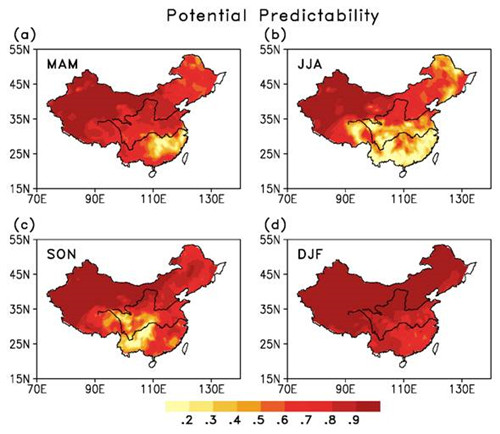Scientists "Catch" the Predictable Signals for Seasonal Forecasting of Soil Moisture over China
Date:2016-01-21
On time-scale of intraseasonal, interannual and interdecadal, soil moisture is a dominant land surface parameter affecting the global atmosphere. As there is a limit for climate prediction, interannual variability of seasonal mean fields arising from variability within the season is essentially unpredictable on seasonal, or longer time scales. Despite the large amount of research on soil moisture variabilities over China, it is still unclear how much of the interannual variability in the seasonal mean soil moisture is related to processes that are potentially predictable and how much is related to intraseasonal variability. Also, little is known about the sources of predictability for the seasonal mean soil moisture in China.
Recently, Dr. YING Kairan and Dr. ZHAO Tianbao from Institute of Atmospheric Physics, Chinese Academy of Sciences, and their collaborators from USA and Australia obtained the monthly mean soil moisture data from a simulation with the Community Land Model version 3.5 and observation-based atmospheric forcing over China. A variance decomposition method was then applied, which can estimate the signal of intraseasonal (unpredictable) and slow (predictable) component, respectively. This methodology provides a way to better identify and understand the source of predictable skill as well as the sources of uncertainty in soil moisture variability.

Fig.1 Spatial distributions of the potential predictability of the top-1m soil moisture across China during a MAM, b JJA, c SON and d DJF for the period 1951-2008 (Figure plotted by IAP)

Fig.2 Spatial distributions of the prediction skill for the top-1m soil moisture across China during a MAM, b JJA, c SON and d DJF. The training period of the prediction scheme was 1951-1991 and the verification period was 1992-2008 (Figure plotted by IAP)
They found that the potential predictability (slow-to-total) of the soil moisture above 1 m is high, with lowest value of 0.76 in JJA and highest value of 0.94 in December-January-February (DJF). The spatial distribution of the potential predictability comprises a northwest–southeast gradient, with a minimum center over East China and a maximum center over the northwest (Fig.1). The most important source of predictability is from the soil moisture persistence, which generally accounts for more than 50 % of the variability in soil moisture. The SSTs in the Indian Ocean, the North Atlantic and the eastern tropical Pacific Oceans are also identified as important sources of variability in the soil moisture, during March-April-May (MAM), June-July-August (JJA) and September-October-November (SON) /DJF, respectively. In addition, prolonged linear trends in each season are an important source. Using the slow principal component time series as predictands, a statistical scheme for the seasonal forecasting of soil moisture across China is developed. The prediction skills, in terms of the percentage of explained variance for the verification period (1992–2008), are 59, 51, 62 and 77 % during MAM, JJA, SON and DJF, respectively (Fig.2).
As the important influences of soil moisture conditions on agriculture, hydrology and climate, skillful seasonal forecasts of soil moisture have obvious potential benefits for practical applications, such as agricultural drought assessments and ecosystem management. This study has been published on Climate Dynamics in 2016.
References
Ying, K., T. Zhao*, X. Zheng, X.-W. Quan, C. S. Frederiksen, M. Li, 2016: Predictable signals in seasonal mean soil moisture simulated with observation-based atmospheric forcing over China, Climate Dynamics, doi: 10.1007/s00382-015-2969-3. (in press)
Contact:
Dr. YING Kairan, yingkr@tea.ac.cn; Dr. ZHAO Tianbao, zhaotb@tea.ac.cn
